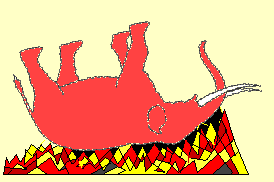Early man spent thousands of years of spearing mastodons. It took a strong throwing arm and good aim to get a stone pointed spear moving upward into the chest cavity of this elephant. Launching the spear with a throwing sling was a later improvement. 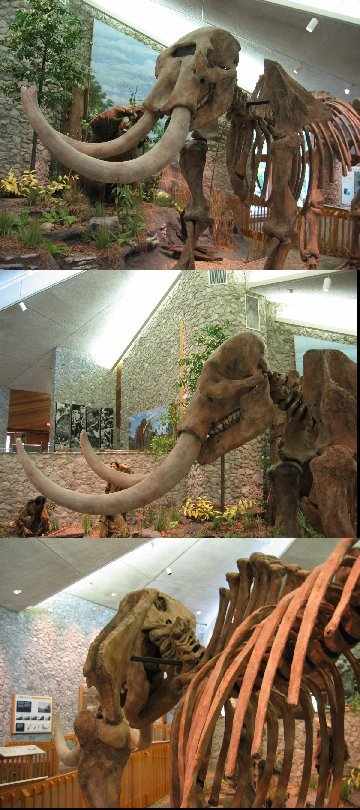 The sling gave a spear greater velocity helping it break through rib bones before striking that massive slow beating heart. Once in a while a Neanderthal hunter would be standing on a bluff above a great mastodon moving below. He could throw downward making a safer kill.
The sling gave a spear greater velocity helping it break through rib bones before striking that massive slow beating heart. Once in a while a Neanderthal hunter would be standing on a bluff above a great mastodon moving below. He could throw downward making a safer kill.
Years went by before a fortuitous accident occurred. A hunter fell off a cliff onto the beast. Fortunately, the spear penetrated the back of the head impaling the mastodon's brain just as this hunter came to rest with legs around the mastodon's neck. This first cowboy enjoyed only a few clicks of time riding the giant to a helpless pile on the ground. At first this episode was an after dinner chalk on black rock drawing report on how it happened. Hundreds of years later it had become folk story material embellished with enthusiastic tones and voice. At some point common tongues and stone pictograms elevated this story to legendary status simply referred to as - "The Feast Kill."
In those days, as is the case even now, a feast brought out the best of folks in the tribe. There were all kinds of festive activities before roasting elephant meat. Of course, one starting a fire which needed friction or sparks and small fluffy scraps of combustible material or gas. Others brought first small sticks then larger dried branches and many logs to make it huge and hot. This may have consumed an entire forest sometimes. Meanwhile, tribal members had to gain courage to go for the elephant, single out a lame sore footed one from the herd and bring it down. The feast area had to be cleaned up, cutting tools needed to be carried to the kill location, parts and pieces of mastodon meat returned to be roasted. Well yes, Eva even burnt some of the fat and unfortunately the meat too.
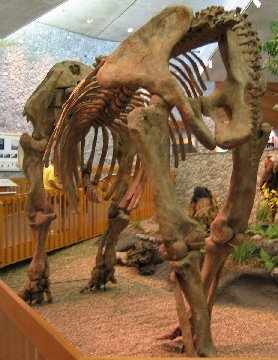 Early man studied proboscidean anatomy in fine detail. After all when you eat something as mammoth as a mastodon there is someone in the tribe that considers this part better than that and tells you why. These comparative anatomy discussions lead to their early understanding of proboscidean foot trouble. Most elephants were slow without even a gallop possibility. With knees slightly bent they could sort of run. Slower lame footed mastodons could usually be found in the herd for these mammals had the propensity to toe dance through life. Occasionally the weight¹ was more than tip toes could stand in various situations. Mastodon anatomy lessons came in the form of delicious food stories for early man. During a festive occasion these stories were told: stories of the great animal hunts, not to mention the constant passing of juicy tidbits of rumors and secrets well known to all who knew them well. Yes, "The Feast Kill" was in the top ten story list for hundreds of years.
Early man studied proboscidean anatomy in fine detail. After all when you eat something as mammoth as a mastodon there is someone in the tribe that considers this part better than that and tells you why. These comparative anatomy discussions lead to their early understanding of proboscidean foot trouble. Most elephants were slow without even a gallop possibility. With knees slightly bent they could sort of run. Slower lame footed mastodons could usually be found in the herd for these mammals had the propensity to toe dance through life. Occasionally the weight¹ was more than tip toes could stand in various situations. Mastodon anatomy lessons came in the form of delicious food stories for early man. During a festive occasion these stories were told: stories of the great animal hunts, not to mention the constant passing of juicy tidbits of rumors and secrets well known to all who knew them well. Yes, "The Feast Kill" was in the top ten story list for hundreds of years.
Some stories reflected the best of early man and inspired future plans. 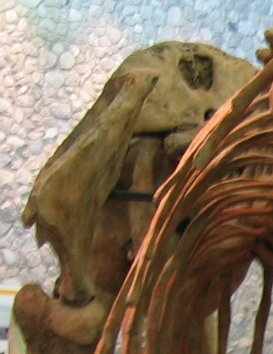 So it was that "The Feast Kill" lead a brave cowboy, Clovis, to suggest to his band that he might hide out in a tree while they drove a lame one underneath. At that moment he would drop onto the mastodon and spear it through the back of the skull. Clovis knew the location of a large depressed area on the skull where a massive band of tissue was attached. Since, for years he had pondered mastodon anatomy specifically: skull, neck, knobby thoracic vertebrae and a tough connective (rubber) band, nuchal ligament, while he ate.
So it was that "The Feast Kill" lead a brave cowboy, Clovis, to suggest to his band that he might hide out in a tree while they drove a lame one underneath. At that moment he would drop onto the mastodon and spear it through the back of the skull. Clovis knew the location of a large depressed area on the skull where a massive band of tissue was attached. Since, for years he had pondered mastodon anatomy specifically: skull, neck, knobby thoracic vertebrae and a tough connective (rubber) band, nuchal ligament, while he ate. 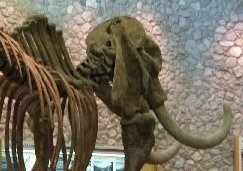 Clovis could kill the beast by driving this spear point, later called "The Clovis Spear Point", through this ligament and bone depression. Hunters went for "The Clovis Plan" and it did work. Often the spear severed the ligament, went through air pocketed bone and cut into some part of a large brain. Well, sometimes he missed and the proboscidean would give him a good ride for the clam shell.
Clovis could kill the beast by driving this spear point, later called "The Clovis Spear Point", through this ligament and bone depression. Hunters went for "The Clovis Plan" and it did work. Often the spear severed the ligament, went through air pocketed bone and cut into some part of a large brain. Well, sometimes he missed and the proboscidean would give him a good ride for the clam shell.
Hundreds of years passed, the once new fable of "The Clovis Point Kill" became old. 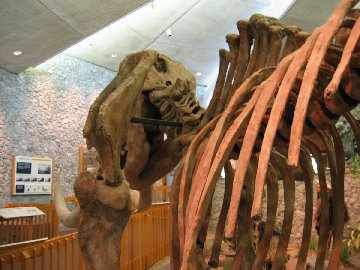 Improved control and killing methods developed such as the use of hand-size stone geodes. Geodes were used to tap the mastodon lightly in the head. This way riders were able to direct the mammal around for some time before a double geode hit followed by a "Clovis Point Special" chop would cause the dropping of its massive head, tusks and trunk just before the fire pit.
Improved control and killing methods developed such as the use of hand-size stone geodes. Geodes were used to tap the mastodon lightly in the head. This way riders were able to direct the mammal around for some time before a double geode hit followed by a "Clovis Point Special" chop would cause the dropping of its massive head, tusks and trunk just before the fire pit. 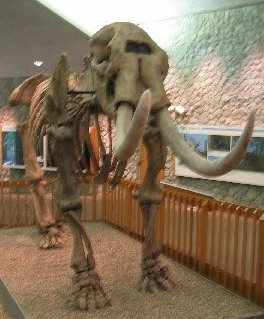 Clovis Jr.^15 had to abort his ridding position at just the right moment. Sure, you can picture the mastodon's head rotating downward, front legs starting into a kneeling motion and thereby allowing this mammoth mastodon to somersault into the flames as it instantly died. If everything went just right the mastodon's final position would have legs straight up and ready for hot pepper sauce. Quetzalcoatlus, flying dinosaur (feathers*?), Wings they were called and enjoyed by all. All the tribe would laugh and celebrate this happening as it had a very strong pre-meal visual look. The spontaneous bend over a belly button laughter was almost as responsive then as salivating from the look and smell of cooking good food today. Then too, there was the additional fun and more funny act of quickly moving in behind the mastodon to push up and forward helping the somersault's initiation. This was the turning point for the creation of the first fast food dinner.
Clovis Jr.^15 had to abort his ridding position at just the right moment. Sure, you can picture the mastodon's head rotating downward, front legs starting into a kneeling motion and thereby allowing this mammoth mastodon to somersault into the flames as it instantly died. If everything went just right the mastodon's final position would have legs straight up and ready for hot pepper sauce. Quetzalcoatlus, flying dinosaur (feathers*?), Wings they were called and enjoyed by all. All the tribe would laugh and celebrate this happening as it had a very strong pre-meal visual look. The spontaneous bend over a belly button laughter was almost as responsive then as salivating from the look and smell of cooking good food today. Then too, there was the additional fun and more funny act of quickly moving in behind the mastodon to push up and forward helping the somersault's initiation. This was the turning point for the creation of the first fast food dinner.

Scott Bussen has occasionally reminded me of how juggling got started maybe 15,000 years ago. Clovis Jr.^17, holding a short Clovis Spear in his teeth, was doing his routine roundup for a fast food feast, riding a nice succulent mastodon toward the large blazing fire pit. He was holding one big round stone geode in each hand about ready to take this succulent mammoth to its death. The two were just several tmhs, tall men's heights, and two turns around the trees and many on-lookers away from the roasting pit when it happened.
Nuggle, not realizing that Clovis had two geodes, lobbed a third one toward Clovis Jr.^17 as he said, "catch this!" 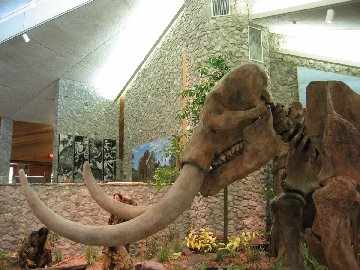 Clovis saw the incoming stone, noted that he had one in each hand as he quickly glanced down, then back at the incoming stone. Clovis figured out the best way to handle this situation was to throw the one in his right hand up in the air about 4 feet and catch the one from Nuggle. Which he did. Pride of catching evaporated into watching the one come down from 4 feet. Glancing again at his full hands, he knew that he had to repeat the procedure, this time throwing the stone from his left hand 4 feet in the air. Catching his previously thrown 4 foot stone in the left hand. He no longer needed to look at full hands as the observed incoming stone had no hand space².
Clovis saw the incoming stone, noted that he had one in each hand as he quickly glanced down, then back at the incoming stone. Clovis figured out the best way to handle this situation was to throw the one in his right hand up in the air about 4 feet and catch the one from Nuggle. Which he did. Pride of catching evaporated into watching the one come down from 4 feet. Glancing again at his full hands, he knew that he had to repeat the procedure, this time throwing the stone from his left hand 4 feet in the air. Catching his previously thrown 4 foot stone in the left hand. He no longer needed to look at full hands as the observed incoming stone had no hand space².
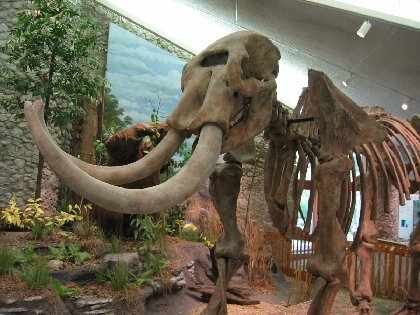
Again, Clovis throws one up from his right hand then from the left. He finds out the best time to toss the next one is just as the last reaches the highest point. Then ... thereby binding himself up in an endless gravity knot of dancing geodes and hands. Members of the tribe standing by the way and beginning the pre-laugh pre-somersault smirking suddenly become loud with cheering, foot stomping³ and clapping. They were amazed with the spectacular "FIRST EVER CIRCUS" appearing in front of their eyes. The awesome revelation that they had just witnessed "THE DAWN OF JUGGLING." Other tribes might reinvent the circus but this was the first known to humans!
 The sling gave a spear greater velocity helping it break through rib bones before striking that massive slow beating heart. Once in a while a Neanderthal hunter would be standing on a bluff above a great mastodon moving below. He could throw downward making a safer kill.
The sling gave a spear greater velocity helping it break through rib bones before striking that massive slow beating heart. Once in a while a Neanderthal hunter would be standing on a bluff above a great mastodon moving below. He could throw downward making a safer kill. Early man studied proboscidean anatomy in fine detail. After all when you eat something as mammoth as a mastodon there is someone in the tribe that considers this part better than that and tells you why. These comparative anatomy discussions lead to their early understanding of proboscidean foot trouble. Most elephants were slow without even a gallop possibility. With knees slightly bent they could sort of run. Slower lame footed mastodons could usually be found in the herd for these mammals had the propensity to toe dance through life. Occasionally the weight¹ was more than tip toes could stand in various situations. Mastodon anatomy lessons came in the form of delicious food stories for early man. During a festive occasion these stories were told: stories of the great animal hunts, not to mention the constant passing of juicy tidbits of rumors and secrets well known to all who knew them well. Yes, "The Feast Kill" was in the top ten story list for hundreds of years.
Early man studied proboscidean anatomy in fine detail. After all when you eat something as mammoth as a mastodon there is someone in the tribe that considers this part better than that and tells you why. These comparative anatomy discussions lead to their early understanding of proboscidean foot trouble. Most elephants were slow without even a gallop possibility. With knees slightly bent they could sort of run. Slower lame footed mastodons could usually be found in the herd for these mammals had the propensity to toe dance through life. Occasionally the weight¹ was more than tip toes could stand in various situations. Mastodon anatomy lessons came in the form of delicious food stories for early man. During a festive occasion these stories were told: stories of the great animal hunts, not to mention the constant passing of juicy tidbits of rumors and secrets well known to all who knew them well. Yes, "The Feast Kill" was in the top ten story list for hundreds of years. So it was that "The Feast Kill" lead a brave cowboy, Clovis, to suggest to his band that he might hide out in a tree while they drove a lame one underneath. At that moment he would drop onto the mastodon and spear it through the back of the skull. Clovis knew the location of a large depressed area on the skull where a massive band of tissue was attached. Since, for years he had pondered mastodon anatomy specifically: skull, neck, knobby thoracic vertebrae and a tough connective (rubber) band, nuchal ligament, while he ate.
So it was that "The Feast Kill" lead a brave cowboy, Clovis, to suggest to his band that he might hide out in a tree while they drove a lame one underneath. At that moment he would drop onto the mastodon and spear it through the back of the skull. Clovis knew the location of a large depressed area on the skull where a massive band of tissue was attached. Since, for years he had pondered mastodon anatomy specifically: skull, neck, knobby thoracic vertebrae and a tough connective (rubber) band, nuchal ligament, while he ate.  Clovis could kill the beast by driving this spear point, later called "The Clovis Spear Point", through this ligament and bone depression. Hunters went for "The Clovis Plan" and it did work. Often the spear severed the ligament, went through air pocketed bone and cut into some part of a large brain. Well, sometimes he missed and the proboscidean would give him a good ride for the clam shell.
Clovis could kill the beast by driving this spear point, later called "The Clovis Spear Point", through this ligament and bone depression. Hunters went for "The Clovis Plan" and it did work. Often the spear severed the ligament, went through air pocketed bone and cut into some part of a large brain. Well, sometimes he missed and the proboscidean would give him a good ride for the clam shell. Improved control and killing methods developed such as the use of hand-size stone geodes. Geodes were used to tap the mastodon lightly in the head. This way riders were able to direct the mammal around for some time before a double geode hit followed by a "Clovis Point Special" chop would cause the dropping of its massive head, tusks and trunk just before the fire pit.
Improved control and killing methods developed such as the use of hand-size stone geodes. Geodes were used to tap the mastodon lightly in the head. This way riders were able to direct the mammal around for some time before a double geode hit followed by a "Clovis Point Special" chop would cause the dropping of its massive head, tusks and trunk just before the fire pit.  Clovis Jr.^15 had to abort his ridding position at just the right moment. Sure, you can picture the mastodon's head rotating downward, front legs starting into a kneeling motion and thereby allowing this mammoth mastodon to somersault into the flames as it instantly died. If everything went just right the mastodon's final position would have legs straight up and ready for hot pepper sauce. Quetzalcoatlus, flying dinosaur (feathers*?), Wings they were called and enjoyed by all. All the tribe would laugh and celebrate this happening as it had a very strong pre-meal visual look. The spontaneous bend over a belly button laughter was almost as responsive then as salivating from the look and smell of cooking good food today. Then too, there was the additional fun and more funny act of quickly moving in behind the mastodon to push up and forward helping the somersault's initiation. This was the turning point for the creation of the first fast food dinner.
Clovis Jr.^15 had to abort his ridding position at just the right moment. Sure, you can picture the mastodon's head rotating downward, front legs starting into a kneeling motion and thereby allowing this mammoth mastodon to somersault into the flames as it instantly died. If everything went just right the mastodon's final position would have legs straight up and ready for hot pepper sauce. Quetzalcoatlus, flying dinosaur (feathers*?), Wings they were called and enjoyed by all. All the tribe would laugh and celebrate this happening as it had a very strong pre-meal visual look. The spontaneous bend over a belly button laughter was almost as responsive then as salivating from the look and smell of cooking good food today. Then too, there was the additional fun and more funny act of quickly moving in behind the mastodon to push up and forward helping the somersault's initiation. This was the turning point for the creation of the first fast food dinner.
 Clovis saw the incoming stone, noted that he had one in each hand as he quickly glanced down, then back at the incoming stone. Clovis figured out the best way to handle this situation was to throw the one in his right hand up in the air about 4 feet and catch the one from Nuggle. Which he did. Pride of catching evaporated into watching the one come down from 4 feet. Glancing again at his full hands, he knew that he had to repeat the procedure, this time throwing the stone from his left hand 4 feet in the air. Catching his previously thrown 4 foot stone in the left hand. He no longer needed to look at full hands as the observed incoming stone had no hand space².
Clovis saw the incoming stone, noted that he had one in each hand as he quickly glanced down, then back at the incoming stone. Clovis figured out the best way to handle this situation was to throw the one in his right hand up in the air about 4 feet and catch the one from Nuggle. Which he did. Pride of catching evaporated into watching the one come down from 4 feet. Glancing again at his full hands, he knew that he had to repeat the procedure, this time throwing the stone from his left hand 4 feet in the air. Catching his previously thrown 4 foot stone in the left hand. He no longer needed to look at full hands as the observed incoming stone had no hand space².
